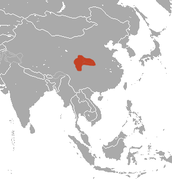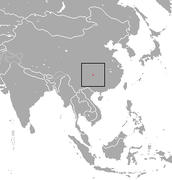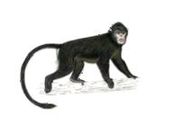Superregnum: Eukaryota
Cladus: Unikonta
Cladus: Opisthokonta
Cladus: Holozoa
Regnum: Animalia
Subregnum: Eumetazoa
Cladus: Bilateria
Cladus: Nephrozoa
Superphylum: Deuterostomia
Phylum: Chordata
Subphylum: Vertebrata
Infraphylum: Gnathostomata
Megaclassis: Osteichthyes
Cladus: Sarcopterygii
Cladus: Rhipidistia
Cladus: Tetrapodomorpha
Cladus: Eotetrapodiformes
Cladus: Elpistostegalia
Superclassis: Tetrapoda
Cladus: Reptiliomorpha
Cladus: Amniota
Cladus: Synapsida
Cladus: Eupelycosauria
Cladus: Sphenacodontia
Cladus: Sphenacodontoidea
Cladus: Therapsida
Cladus: Theriodontia
Cladus: Cynodontia
Cladus: Eucynodontia
Cladus: Probainognathia
Cladus: Prozostrodontia
Cladus: Mammaliaformes
Classis: Mammalia
Subclassis: Trechnotheria
Infraclassis: Zatheria
Supercohors: Theria
Cohors: Eutheria
Infraclassis: Placentalia
Cladus: Boreoeutheria
Superordo: Euarchontoglires
Ordo: Primates
Subordo: Haplorhini
Infraordo: Simiiformes
Parvordo: Catarrhini
Superfamilia: Cercopithecoidea
Familia: Cercopithecidae
Subfamilia: Colobinae
Tribus: Presbytini
Genus: Rhinopithecus
Species (5): R. avunculus – R. bieti – R. brelichi – R. roxellana – R. strykeri
Name
Rhinopithecus Milne-Edwards, 1872: 233
Type species: Semnopithecus roxellana Milne-Edwards, 1872, by monotypy.
Synonyms
Presbytiscus Pocock, 1924: 330
Type species: Rhinopithecus avunculus Dollman, 1912, by original designation.
Taxonomic note
Included in Pygathrix by Groves (1970) and Szalay & Delson (1979: 404); but see Jablonski & Peng (1993) and Groves (2001c), who recognized that the two are sister-groups but retained them as separate genera. Jablonski & Peng (1993) recognized Presbytiscus as a valid subgenus.
References
Primary references
Milne-Edwards, A. 1872. Mémoire de la faune mammalogique du Tibet Oriental et principalement de la principauté de Moupin. Pp. 231–379 in Milne-Edwards, H. (ed.), Recherches pour servir à l’histoire naturelle des mammifères. 2 volumes. G. Masson: Paris. Tome Premier - Texte: BHL; Tome Second - Atlas: BHL. Reference page.
Pocock, R.I. 1924. A new genus of monkeys. Proceedings of the Zoological Society of London 1924: 330–331.
Additional references
Geissmann, T., Lwin, N., Aung, S.S., Aung, T.N., Aung, Z.M., Hla, T.H., Grindley, M. & Momber, F. 2011. A new species of snub-nosed monkey, genus Rhinopithecus Milne-Edwards, 1872 (Primates, Colobinae), from northern Kachin state, northeastern Myanmar. American Journal of Primatology 73(1): 96–107. DOI: 10.1002/ajp.20894
Links
Rhinopithecus in Mammal Species of the World.
Wilson, Don E. & Reeder, DeeAnn M. (Editors) 2005. Mammal Species of the World – A Taxonomic and Geographic Reference. Third edition. ISBN 0-8018-8221-4.
Vernacular names
Deutsch: Stumpfnasenaffen
English: Snub-nosed monkeys
日本語: シシバナザル属
português: Macaco-dourado
ไทย: ลิงจมูกเชิด, ค่างจมูกเชิด
中文: 仰鼻猴属
Snub-nosed monkeys are a group of Old World monkeys and make up the entirety of the genus Rhinopithecus. The genus is rare and not fully researched. Some taxonomists group snub-nosed monkeys together with the genus Pygathrix.
Distribution and habitat
Snub-nosed monkeys live in Asia, with a range covering southern China (especially Tibet, Sichuan, Yunnan, and Guizhou) extending into the northern parts of Myanmar and Vietnam. Snub-nosed monkeys inhabit mountain forests up to elevations of more than 4,000 m (13,000 ft). In the winter, they move into the deeply secluded regions. Higher elevation areas are more remote and difficult for humans to access and utilize and other studies have found less deforestation, more reforestation and afforestation, less range contraction, and less extinction in topographically steep areas. All Rhinopithecus species inhabit primary forest and grid cells with tree cover ≥ 75% might constitute important potential habitat.[1]
Description
These monkeys are named for the short stump of a nose on their round faces, with nostrils arranged forward. They have relatively multicolored and long fur, particularly at the shoulders and backs. They grow to a length of 51–83 cm (20–33 in) with a tail of 55–97 cm (22–38 in).
Behavior
Snub-nosed monkeys spend the majority of their life in the trees. They live together in very large groups of up to 600 members, splitting up into smaller groups in times of food-scarcity, such as in the winter. Groups consist of many more males than females. They have territorial instincts, defending their territory mostly with shouts. They have a large vocal repertoire, calling sometimes solo while at other times together in choir-like fashion.
Diet
The diet of these animals consists mainly of tree needles, bamboo buds, fruits and leaves. A multi-chambered stomach helps them with digesting their food.
Breeding
The impulse for mating starts with the female. She takes up eye contact with the male and runs away a short bit, then flashes her genitals. If the male shows interest (which does not always occur), he joins the female and they mate. The 200-day gestation period ends with a single birth in late spring or early summer. Young animals become fully mature in about six to seven years. Zoologists know little about their lifespan.
Conservation
The golden[2] and black-and-white snub-nosed monkeys[3] are both endangered species, while the other three species are critically endangered.[4][5][6]
Golden snub-nosed monkey communities with large populations have high genetic diversity, but also show higher levels of recent inbreeding than other snub-nosed monkeys.[7]
Species
| Common name | Scientific name and subspecies | Range | Size and ecology | IUCN status and estimated population |
|---|---|---|---|---|
| Black-and-white snub-nosed monkey
|
R. bieti A. Milne-Edwards, 1897 |
Southern China |
Size: 74–83 cm (29–33 in) long, plus 51–72 cm (20–28 in) tail[8] Habitat: Forest[3] Diet: Leaves, fruit, and lichen[8] |
EN
|
| Golden snub-nosed monkey
|
R. roxellana (A. Milne-Edwards, 1870) |
|
Three subspecies
|
Central China |
Size: 57–76 cm (22–30 in) long, plus 51–72 cm (20–28 in) tail[9] Habitat: Forest[2] Diet: Leaves, bark, and lichen, as well as buds and fruit seeds[9] |
EN
|
|
| Gray snub-nosed monkey
|
R. brelichi Thomas, 1903 |
Central China |
Size: About 64–73 cm (25–29 in) long, plus 70–97 cm (28–38 in) tail[10] Habitat: Forest[4] Diet: Leaves, buds, fruit, seeds and bark, as well as insect larvae[10] |
CR
|
|---|---|---|---|---|
| Myanmar snub-nosed monkey
|
R. strykeri Geissmann et al., 2010 |
Northern Myanmar |
Size: About 56 cm (22 in) long, plus 78 cm (31 in) tail[11] Habitat: Forest[6] Diet: Leaves, fruit, seeds, buds, flowers, twigs, and bark[12] |
CR
|
| Tonkin snub-nosed monkey
|
R. avunculus Dollman, 1912 |
Northern Vietnam |
Size: 51–65 cm (20–26 in) long, plus 66–92 cm (26–36 in) tail[13] Habitat: Forest[5] Diet: Leaves, fruit, flowers, and seeds[13] |
CR
|
See also
Wildlife of China
References
Nüchel, Jonas; Bøcher, Peder Klith; Xiao, Wen; et al. (2018-01-23). "Snub-nosed monkeys (Rhinopithecus): potential distribution and its implication for conservation". Biodiversity and Conservation. 27 (6): 1517–1538. doi:10.1007/s10531-018-1507-0. ISSN 0960-3115. PMC 6560942. PMID 31258260.
Yongcheng, L.; Richardson, M. (2021) [amended version of 2020 assessment]. "Rhinopithecus roxellana". IUCN Red List of Threatened Species. 2021: e.T19596A196491153. doi:10.2305/IUCN.UK.2021-1.RLTS.T19596A196491153.en.
Long, Y.; Bleisch, W. V.; Richardson, M. (2020). "Rhinopithecus bieti". IUCN Red List of Threatened Species. 2020: e.T19597A17943738. doi:10.2305/IUCN.UK.2020-2.RLTS.T19597A17943738.en.
Long, Y.; Li, B.; Zhou, J.; Ren, B.; Garber, A. (2022). "Rhinopithecus brelichi". IUCN Red List of Threatened Species. 2022: e.T19595A215621115. doi:10.2305/IUCN.UK.2022-1.RLTS.T19595A215621115.en.
Quyet, L. K.; Rawson, B. M.; Duc, H.; Nadler, T.; Covert, H.; Ang, A. (2020). "Rhinopithecus avunculus". IUCN Red List of Threatened Species. 2020: e.T19594A17944213. doi:10.2305/IUCN.UK.2020-2.RLTS.T19594A17944213.en.
Geissmann, T.; Momberg, F.; Whitten, T. (2020). "Rhinopithecus strykeri". IUCN Red List of Threatened Species. 2020: e.T13508501A17943490. doi:10.2305/IUCN.UK.2020-2.RLTS.T13508501A17943490.en.
Kuang, W.; Hu, J.; et al. (December 2020). "Genetic diversity, inbreeding level, and genetic load in endangered snub-nosed monkeys (Rhinopithecus)". Frontiers in Genetics. 11: 615926. doi:10.3389/fgene.2020.615926.
Deng, Xin (2020). "Rhinopithecus bieti". Animal Diversity Web. University of Michigan. Archived from the original on August 12, 2023. Retrieved July 24, 2023.
Munoz, Peter (2023). "Rhinopithecus roxellana". Animal Diversity Web. University of Michigan. Archived from the original on August 12, 2023. Retrieved July 24, 2023.
"Grey snub-nosed monkey (Rhinopithecus brelichi)". ARKive. Wildscreen. Archived from the original on September 9, 2015. Retrieved December 16, 2013.
Geissmann, T.; Lwin, N.; Aung, S. S.; Aung, T. N.; Aung, Z. M.; Hla, T. H.; Grindley, M.; Momberg, F. (2011). "A new species of snub-nosed monkey, genus Rhinopithecus Milne-Edwards, 1872 (Primates, Colobinae), from northern Kachin state, northeastern Myanmar". American Journal of Primatology. 73 (1): 96–107. doi:10.1002/ajp.20894. PMID 20981682. S2CID 467234. Archived from the original on June 8, 2023. Retrieved August 24, 2023.
Yang, Y.; Groves, C.; Garber, P.; Wang, X.; Li, H.; Long, Y.; Li, G.; Tian, Y.; Dong, S. (2019). "First insights into the feeding habits of the Critically Endangered black snub-nosed monkey, Rhinopithecus strykeri (Colobinae, Primates)". Primates. 60 (2): 143–153. doi:10.1007/s10329-019-00717-0. PMID 30847671. S2CID 71145324.
Cherka, Rachel (2014). "Rhinopithecus avunculus". Animal Diversity Web. University of Michigan. Archived from the original on August 12, 2023. Retrieved July 24, 2023.
Retrieved from "http://en.wikipedia.org/"
All text is available under the terms of the GNU Free Documentation License






